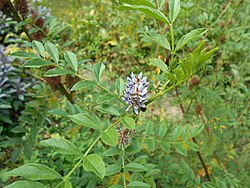| Glycyrrhiza echinata | |
|---|---|
 | |
| Scientific classification | |
| Kingdom: | Plantae |
| Clade: | Tracheophytes |
| Clade: | Angiosperms |
| Clade: | Eudicots |
| Clade: | Rosids |
| Order: | Fabales |
| Family: | Fabaceae |
| Subfamily: | Faboideae |
| Genus: | Glycyrrhiza |
| Species: | G. echinata |
| Binomial name | |
| Glycyrrhiza echinata | |
| Synonyms [2] | |
| |
Glycyrrhiza echinata is a species of flowering plant in the genus Glycyrrhiza , with various common names that include Chinese licorice, [3] German licorice, [3] [4] and hedgehog licorice, [3] Eastern European licorice, [5] Hungarian licorice, [6] Prickly licorice, [7] and Roman licorice. [8]